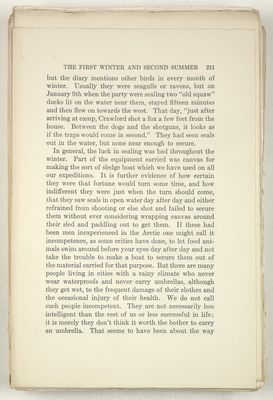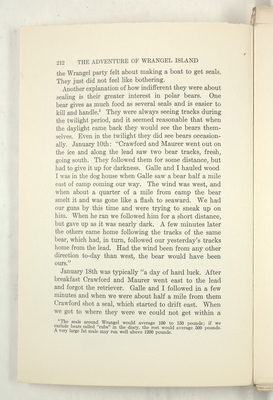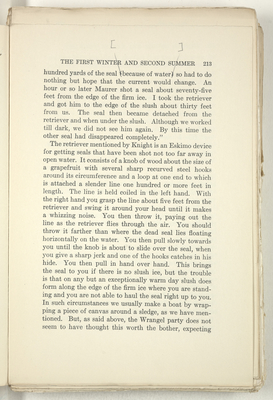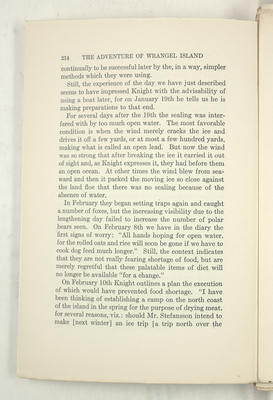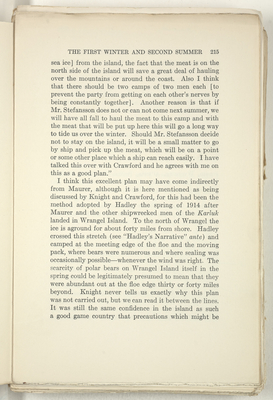Pages
stefansson-wrangel-09-32-001r
THE FIRST WINTER AND SECOND SUMMER 211
but the diary mentions other birds in every month of winter. Usually they were seagulls or ravens, but on January 9th when the party were sealing two “old squaw” ducks lit on the water near them, stayed fifteen minutes and then flew on towards the west. That day, “just after arriving at camp, Crawford shot a fox a few feet from the house. Between the dogs and the shotguns, it looks as if the traps would come in second.” They had seen seals out in the water, but none near enough to secure.
In general, the luck in sealing was bad throughout the winter. Part of the equipment carried was canvas for making the sort of sledge boat which we have used on all our expeditions. It is further evidence of how certain they were that fortune would turn some time, and how indifferent they were just when the turn should come, that they saw seals in open water day after day and either refrained from shooting or else shot and failed to secure them without ever considering wrapping canvas around their sled and paddling out to get them. If these had been men inexperienced in the Arctic one might call it incompetence, as some critics have done, to let food animals swim around before your eyes day after day and not take the trouble to make a boat to secure them out of the material carried for that purpose. But there are many people living in cities with a rainy climate who never wear waterproofs and never carry umbrellas, although they get wet, to the frequent damage of their clothes and the occasional injury of their health. We do not call such people incompetent. They are not necessarily less intelligent than the rest of us or less successful in life; it is merely they don’t think it worth the bother to carry an umbrella. That seems to have been about the way
stefansson-wrangel-09-32-001v
212 THE ADVENTURE OF WRANGEL ISLAND
the Wrangel party felt about making a boat to get seals. They just did not feel like bothering.
Another explanation of how indifferent they were about sealing is their greater interest in polar bears. One bear gives as much food as several seals and is easier to kill and handle.2 They were always seeing tracks during the twilight period, and it seemed reasonable that when the daylight came back they would see the bears themselves. Even in the twilight they did see bears occasionally. January 10th: “Crawford and Maurer went out on the ice and along the lead saw two bear tracks, fresh, going south. They followed them for some distance, but had to give it up for darkness. Galle and I hauled wood. I was in the dog house when Galle saw a bear half a mile east of camp coming our way. The wind was west, and when about a quarter of a mile from camp the bear smelt it and was gone like a flash to seaward. We had our guns by this time and were trying to sneak up on him. When he ran we followed him for a short distance, but gave up as it was nearly dark. A few minutes later the others came home following the tracks of the same bear, which had, in turn, followed our yesterday’s tracks home from the lead. Had the wind been from any other direction to-day than west, the bear would have been ours.”
January 18th was typically “a day of hard luck. After breakfast Crawford and Maurer went east to the lead and forgot the retriever. Galle and I followed in a few minutes and when we were about half a mile from them Crawford shot a seal, which started to drift east. When we got to where they were we could not get within a
2 The seals around Wrangel would average 100 to 150 pounds; if we exclude bears called “cubs” in the diary, the rest would average 500 pounds. A very large fat male may run well above 1200 pounds.
stefansson-wrangel-09-32-002r
THE FIRST WINTER AND SECOND SUMMER 213
hundred yards of the seal [because of water] so had to do nothing but hope that the current would change. An hour or so later Maurer shot a seal about seventy-five feet from the edge of the firm ice. I took the retriever and got him to the edge of the slush about thirty feet from us. The seal then became detached from the retriever and when under the slush. Although we worked till dark, we did not see him again. By this time the other seal had disappeared completely.”
The retriever mentioned by Knight is an Eskimo device for getting seals that have been shot not too far away in open water. It consists of a knob of wood about the size of a grapefruit with several sharp recurved steel hooks around its circumference and a loop at one end to which is attached a slender line one hundred or more feet in length. The line is held coiled in the left hand. With the right hand you grasp the line about five feet from the retriever and swing it around your head until it makes a whizzing noise. You then throw it, paying out the line as the retriever flies through the air. You should throw it farther than where the dead seal lies floating horizontally on the water. You then pull slowly towards you until the knob is about to slide over the seal, when you give a sharp jerk and one of the hooks catches in his hide. You then pull in hand over hand. This brings the seal to you if there is no slush ice, but the trouble is that on any but an exceptionally warm day slush does form along the edge of the firm ice where you are standing and you are not able to haul the seal right up to you. In such circumstances we usually make a boat by wrapping a piece of canvas around a sledge, as we have mentioned. But, as said above, the Wrangel party does not seem to have thought this worth the bother, expecting
stefansson-wrangel-09-32-002v
214 THE ADVENTURE OF WRANGEL ISLAND
continually to be successful later by the, in a way, simpler methods which they were using.
Still, the experience of the day we have just described seems to have impressed Knight with the advisability of using a boat later, for on January 19th he tells us he is making preparations to that end.
For several days after the 19th the sealing was interfered with by too much open water. The most favorable condition is when the wind merely cracks the ice and drives it off a few yards, or at most a few hundred yards, making what is called an open lead. But now the wind was so strong that after breaking the ice it carried it out of sight and, as Knight expresses it, they had before them an open ocean. At other times the wind blew from seaward and then it packed the moving ice so close against the land floe that there was no sealing because of the absence of water.
In February they began setting traps again and caught a number of foxes, but the increasing visibility due to the lengthening day failed to increase the number of polar bears seen. On February 8th we have in the diary the first signs of worry: “All hands hoping for open water, for the rolled oats and rice will soon be gone if we have to cook dog feed much longer.” Still, the context indicates that they are not really fearing shortage of food, but are merely regretful that these palatable items of diet will no longer be available “for a change.”
On February 10th Knight outlines a plan the execution of which would have prevented food shortage. “I have been thinking of establishing a camp on the north coast of the island in the spring for the purpose of drying meat, for several reasons, viz.: should Mr. Stefansson intend to make [next winter] an ice trip [a trip north over the
stefansson-wrangel-09-32-003r
THE FIRST WINTER AND SECOND SUMMER 215
sea ice] from the island, the fact that the meat is on the north side of the island will save a great deal of hauling over the mountains or around the coast. Also I think that there should be two camps of two men each [to prevent the party from getting on each other’s nerves by being constantly together]. Another reason is that if Mr. Stefansson does not or can not come next summer, we will have all fall to haul the meat to this camp and with the meat that will be put up here this will go a long way to tide us over the winter. Should Mr. Stefansson decide not to stay on the island, it will be a small matter to go by ship and pick up the meat, which will be on a point or some other place which a ship can reach easily. I have talked this over with Crawford and he agrees with me on this as a good plan.”
I think this excellent plan may have come indirectly from Maurer, although it is here mentioned as being discussed by Knight and Crawford, for this had been the method adopted by Hadley the spring of 1914 after Maurer and the other shipwrecked men of the Karluk landed in Wrangel Island. To the north of Wrangel the ice is aground for about forty miles from shore. Hadley crossed this stretch (see “Hadley’s Narrative” ante) and camped at the meeting edge of the floe and the moving pack, where bears were numerous and where sealing was occasionally possible—whenever the wind was right. The scarcity of polar bears on Wrangel Island itself in the spring could be legitimately presumed to mean that they were abundant out at the floe edge thirty or forty miles beyond. Knight never tells us exactly why this plan was not carried out, but we can read it between the lines. It was still the same confidence in the island as such a good game country that precautions which might be
